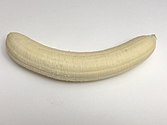BRAT diet
The BRAT diet ("Bananas, Rice, Apple sauce, Toast") is a restrictive diet that was once recommended for people, particularly children, with gastrointestinal distress like vomiting, diarrhea, or gastroenteritis. Evidence, however, does not support a benefit.[1] As of the 21st century, it is no longer recommended, as it is unnecessarily restrictive.[1][2] The diet was first discussed in 1926.[1]
An acronym, BRAT stands for bananas, rice, apple sauce, and toast, the four food components of the diet.[1] Additionally, it is recommended[by whom?] that all people, regardless of age, drink plenty of fluids to prevent dehydration, along with oral rehydration solutions to replace the depleted electrolytes and avoid salt imbalance.[3] Severe, untreated salt imbalance can result in "extreme weakness, confusion, coma, or death."[4]
Nutritional analysis
[edit]The BRAT diet is no longer generally recommended.[2] The American Academy of Pediatrics states that most children should continue a normal, age appropriate diet. The foods from the BRAT diet may be added, but should not replace normal, tolerated foods. Sugary drinks and carbonated beverages should be avoided.[5] The BRAT diet is no longer routinely recommended to those who have had stem cell transplants and have diarrhea due to graft-versus-host disease, as long-term use can lead to nutritional deficiencies.
Adding rice, bananas, or pectin to the diet while suffering from diarrhea may be beneficial, but physicians Debora Duro and Christopher Duggan point out that the diet is not nutritionally complete and may be deficient in energy, fat, protein, fiber, vitamin A, vitamin B12, and calcium. Duro and Duggan also say that food restriction does not alleviate diarrhea and actually causes individuals to have diarrhea for longer periods, according to randomized clinical trials.[6]
Medical attention is required when on the BRAT diet if any blood or mucus is present in the diarrhea, if the diarrhea is severe, or if it lasts longer than 3 days.[7]
Alternatives
[edit]Medical professionals advise first aid treatment for gastroenteritis[8] by briefly limiting the diet to bland, easy-to-digest foods (similar to those of the BRAT diet or the CRAM diet) and plenty of liquids (including oral rehydration therapy, e.g. oral pediatric electrolyte solutions sold at retail).[9]
See also
[edit]References
[edit]- ^ a b c d Mackell S (1 December 2005). "Traveler's diarrhea in the pediatric population: etiology and impact". Clinical Infectious Diseases. 41 (Suppl 8): S547-52. doi:10.1086/432950. PMID 16267717.
- ^ a b King CK, Glass R, Bresee JS, Duggan C (November 2003). "Managing acute gastroenteritis among children: oral rehydration, maintenance, and nutritional therapy". MMWR Recomm Rep. 52 (RR-16): 1–16. PMID 14627948.
- ^ Duggan C, Santosham M, Glass RI (16 October 1992). "The management of acute diarrhea in children: oral rehydration, maintenance, and nutritional therapy. Centers for Disease Control and Prevention". MMWR. Recommendations and Reports. 41 (RR-16): 1–20. PMID 1435668.
- ^ McLaughlin E (24 July 2000). "salt imbalance". Archived from the original on 2 July 2007. Retrieved 8 April 2007.
- ^ Kyle T (2008). Essentials of pediatric nursing. Lippincott Williams & Wilkins. p. 685. ISBN 978-0-7817-5115-5.
- ^ Duro D, Duggan C (June 2007). "The BRAT Diet for Acute Diarrhea in Children: Should It Be Used?" (PDF). Practical Gastroenterology. Retrieved 25 October 2009.
- ^ "BRAT diet: What is the BRAT diet?". C. S. Mott Children's Hospital. University Of Michigan. Archived from the original on 20 February 2007. Retrieved 8 April 2007.
- ^ "Gastroenteritis". MedlinePlus. United States National Library of Medicine. Retrieved 18 November 2022.
- ^ Mayo Clinic Staff. "Gastroenteritis: First aid". Mayo Clinic. Retrieved 6 March 2011.




